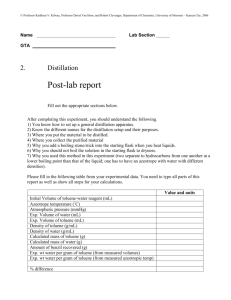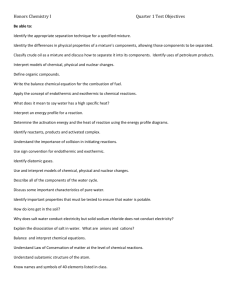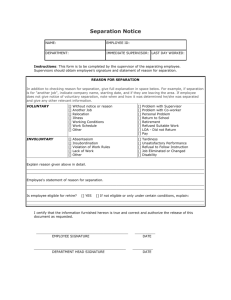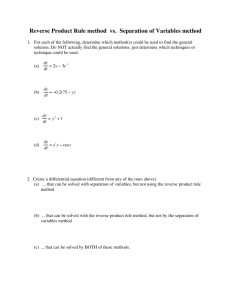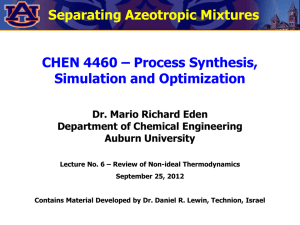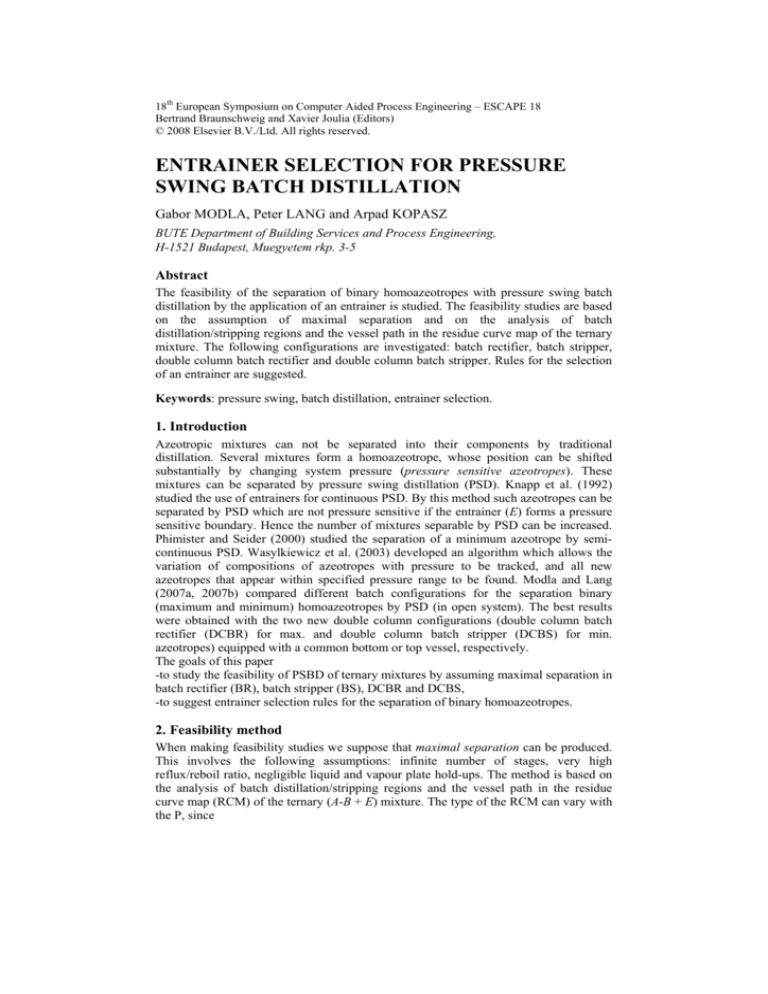
18th European Symposium on Computer Aided Process Engineering – ESCAPE 18
Bertrand Braunschweig and Xavier Joulia (Editors)
© 2008 Elsevier B.V./Ltd. All rights reserved.
ENTRAINER SELECTION FOR PRESSURE
SWING BATCH DISTILLATION
Gabor MODLA, Peter LANG and Arpad KOPASZ
BUTE Department of Building Services and Process Engineering,
H-1521 Budapest, Muegyetem rkp. 3-5
Abstract
The feasibility of the separation of binary homoazeotropes with pressure swing batch
distillation by the application of an entrainer is studied. The feasibility studies are based
on the assumption of maximal separation and on the analysis of batch
distillation/stripping regions and the vessel path in the residue curve map of the ternary
mixture. The following configurations are investigated: batch rectifier, batch stripper,
double column batch rectifier and double column batch stripper. Rules for the selection
of an entrainer are suggested.
Keywords: pressure swing, batch distillation, entrainer selection.
1. Introduction
Azeotropic mixtures can not be separated into their components by traditional
distillation. Several mixtures form a homoazeotrope, whose position can be shifted
substantially by changing system pressure (pressure sensitive azeotropes). These
mixtures can be separated by pressure swing distillation (PSD). Knapp et al. (1992)
studied the use of entrainers for continuous PSD. By this method such azeotropes can be
separated by PSD which are not pressure sensitive if the entrainer (E) forms a pressure
sensitive boundary. Hence the number of mixtures separable by PSD can be increased.
Phimister and Seider (2000) studied the separation of a minimum azeotrope by semicontinuous PSD. Wasylkiewicz et al. (2003) developed an algorithm which allows the
variation of compositions of azeotropes with pressure to be tracked, and all new
azeotropes that appear within specified pressure range to be found. Modla and Lang
(2007a, 2007b) compared different batch configurations for the separation binary
(maximum and minimum) homoazeotropes by PSD (in open system). The best results
were obtained with the two new double column configurations (double column batch
rectifier (DCBR) for max. and double column batch stripper (DCBS) for min.
azeotropes) equipped with a common bottom or top vessel, respectively.
The goals of this paper
-to study the feasibility of PSBD of ternary mixtures by assuming maximal separation in
batch rectifier (BR), batch stripper (BS), DCBR and DCBS,
-to suggest entrainer selection rules for the separation of binary homoazeotropes.
2. Feasibility method
When making feasibility studies we suppose that maximal separation can be produced.
This involves the following assumptions: infinite number of stages, very high
reflux/reboil ratio, negligible liquid and vapour plate hold-ups. The method is based on
the analysis of batch distillation/stripping regions and the vessel path in the residue
curve map (RCM) of the ternary (A-B + E) mixture. The type of the RCM can vary with
the P, since
2
G. Modla et al.
-azeotrope(s) can appear or disappear and/or
-the volatility order of the pure components (eg one pressure is below and the other
pressure is above the Bancroft point of the two components) and azeotropes can vary.
For the PSBD the classification of the RCM (eg by Matsuyama and Nishimura (1977,
M&N) by Serafimov (1970, S)) must be extended. The pressure sensitivity of an
azeotrope must be always indicated even if there is no change in the type of RCM since
it has influence on the separation method to be applied. (We write ‘P’ after the number
of M&N if it is sensitive). If the type of RCM varies it must be given for both pressures.
Feasibility region of the separation (FR) is defined as follows:
All feed compositions, from where all components can be purely recovered by maximal
separation at the given pressure or by applying pressure swing.
The regions outside the FR can be
-conditionally feasible: from where FR can be reached by a preparatory step
(distillation/stripping or addition of E)
-infeasible: from where a FR can not be reached.
3. Column configurations
First the separation steps of the configurations with one column section (BR and BS)
then those of the double column systems (DCBR and DCBS) will be presented.
3.1. Configurations with one column section
In this case the pressure swing can be performed only in time. Hence in one cycle there
must be at least two sequential production steps at different pressures. The separation
steps are as follows
0. Preparation (distillation/stripping or addition of E until the vessel path (vp) arrives at
FR, optional).
1. Production cycle:
1.I.a. Production of A or B at PI until vp reaches the boundary at the given pressure.
1.I.b. Change of pressure.
1.II.a. Production of the other component at PII until vp reaches the boundary.
1.II.b. Change of pressure.
2. Repetition of the production cycles until at least one component is completely
recovered.
3.2. Double column systems
The two different pressures are applied in different column sections. In this case it is
theoretically possible to produce three pure components in a single production step.
(Two components are withdrawn continuously and the third remains in the vessel.) The
separation steps are as follows
0. Preparation (optional): distillation/stripping (operation of one of the columns) and/or
addition of E.
1. Production:
Production of A or B at PI and the other component or E at PII until at least one
component is completely recovered.
4. Feasibility studies
The feasibility of the separation of the azeotrope A-B from a binary mixture depends on
its type (min. or max.) and pressure sensitivity (Y/N). If there is also a third component
(E) in the mixture the separation method to be applied depends obviously on its boiling
ENTRAINER SELECTION FOR PRESSURE SWING BATCH DISTILLATION
3
point (comparing with that of A, B and azeotrope A-B). If E forms one new binary
azeotrope the feasibility also depends on its temperature (min./max., unstable or stable
node or saddle) and pressure sensitivity (Y/N).
First we study those cases where A and B form a pressure sensitive azeotrope and a third
component not forming a new azeotrope is also present in the feed. Then we investigate
such cases where the azeotrope A-B is not pressure sensitive, therefore an entrainer is
applied for their PSBD separation. We study only those entrainers which form one new
binary pressure sensitive azeotrope. In this paper only some typical cases are shown.
4.1. Pressure sensitive A-B azeotrope
The separation of the A-B minimum azeotrope with third components (E) of different
volatility (H,I,L) will be shown in details.
4.1.1. Light E
On the sketch of the residue curve map (RCM) the azeotrope is saddle, E is unstable
while A and B are stable nodes (Fig. 1a). The class of the RCM by the (extended )
Matsuyama and Nishimura (M&N): 0-2P-0 (by Serafimov (S): 1.0-2, eg n-butyl ethern-butanol + acetone). The RCM contains two simple and two batch distillation and
stripping (maximal separation) regions. The location of the boundary (line between AzAB
and E) between the two regions considerably varies with the pressure (Figs. 1b-c).
E
E
E
B
Az
I
AB
A
B
Az
I
Az
II
A
B
Az
I
AB
AB
AB
Fig. 1. Pressure sensitive A-B min. azeotrope and a light E
Az
II
A
AB
The feasible region (FR) is the (darkened) area between the boundaries at two pressures.
The remaining area of the triangle forms the conditionally feasible region (CFR).
Configurations recommended: batch stripper (Fig. 1b) or DCBS (Fig. 1c).
The separation method recommended consists of the following steps:
0 (optional). Removal of some A or B. (From CFR the vessel path must arrive at FR.)
1. Separation by pressure swing distillation (the vessel paths (dashed) and for the DCBS
the concentration profiles (dotted) are shown in. Figs. 1b-c). (In the case of BS this step
consists of several parts and requires several changes of P.)
It must be still noted that there is another possibility for the separation but this requires
change of configuration. First E can be removed by rectification and then the remaining
A-B mixture can be separated by pressure swing stripping in a BS or DCBS.
4.1.2. Intermediate E
The azeotrope is unstable, B is stable node, respectively. A and E are saddles. The class
of the RCM: M&N: 0-0-1P (S:1.0-1b, eg acetone-heptane + benzene).
The separation is feasible without applying pressure swing. The method recommended:
1. Production of B by batch stripping.
2. Separation A/E in a batch stripper (or rectifier).
4
G. Modla et al.
4.1.3. Heavy E
The azeotrope is unstable, E is stable node, respectively. A and B are saddles (Fig. 2).
The RCM (M&N: 1P-0-0) contains only one simple but two BD and BS regions.
(S: 1.0-1a, eg CCl4-ethanol+acrylic acid). The location of the boundary (line between
AzAB and E) considerably varies with the pressure.
E
E
Unstable node
Stable node
Saddle
B
A
Az
AB
B
Az
I
AB
Az
II
A
AB
Fig. 2. Mixture of a pressure sensitive A-B min. azeotrope and a heavy E
By the definitions above the feasible region (FR) is only the line between AzIAB and
AzIIAB. However the conditionally feasible region (CFR) is the whole area of the
triangle. Configurations recommended: batch stripper or double column batch stripper.
The separation steps recommended:
0. Removal of E (at the end the vp arrives at the AB edge).
1. Separation of the binary mixture A-B by pressure swing distillation.
The separation method for the max. azeotropes can be obtained as follows:
a. Exchange of stable and unstable nodes (from a min. azeotrope+heavy E we get a
max. azeotrope+light E). b. Application of the method proposed for min. azeotropes
(having this RCM) by exchanging the configuration (from BS/DCBSR to BR/DCBR).
4.2. Pressure insensitive A-B azeotrope
In this chapter those cases are investigated where the azeotrope A-B is not pressure
sensitive, therefore an entrainer (causing a pressure sensitive boundary) must be applied
for their separation by PSBD. The separation of only a binary min. azeotrope will be
shown in details for those cases where E forms a new min. azeotrope (B-E).
4.2.1. Light E
At PI the azeotrope A-B and E are saddles, pure A and B are stable nodes and the
azeotrope B-E is unstable node (Fig. 3.a). The RCM (M&N: 1P-2-0,S: 2.0-2b) contains
two simple and two BD/BS regions. The location of the boundary (line between AzAB
and AzBE ) considerably varies with the pressure (due to the movement of AzBE, Fig. 3c.)
. The feasible region (FR) is the area between the boundaries at the different pressures.
The remaining area of the triangle forms the conditionally feasible region (CFR). The
configurations recommended: batch stripper (Fig. 3c) or double column batch stripper
(Fig. 3d). The separation method recommended contains the following steps:
0.Removal of A or B or adding E (optional).
1. Production of A and B by PSD (by the aid of E).
2. Separation B/E by PSD.
It must be still noted that with the variation of the pressure (eg at PIII) the azeotrope B-E
can even disappear (Fig. 3b). In this case the topology of the residue curve map changes
(to Class S: 1.0-2, M&N: 0-2-0). Hence the feasible region is the area AzAB-AzBEI-E.
ENTRAINER SELECTION FOR PRESSURE SWING BATCH DISTILLATION
E
Az
5
E
I
BE
B
A
Az
B
a.Sketch of RCM at PI
E
Az
AB
b.Sketch of RCM at PIII (AzBEI disapperared)
E
II
Az
BE
Az
A
Az
AB
Az
I
I
II
BE
BE
BE
B
A
Az
B
A
Az
AB
AB
c. Vessel path for the BS
d. Vessel path for the DCBS
Fig. 3. Min. azeotrope A-B + light E forming a min. azeotrope B-E
The recommended configurations are the same as above. In this case the separation B/E
(at PIII) does not require pressure swing.
4.2.2. Intermediate E
The azeotrope A-B and pure A are saddles, pure B and E are stable nodes and the
azeotrope B-E is unstable node (Fig. 4).
The RCM (M&N: 0-1P-2, S: 2.0-2c,) contains two simple and two BD/BS regions. The
location of the boundary (line between AzAB and AzBE) considerably varies with P. The
ternary mixture in the triangle AzBE-A-E (darkened area) can be separated by the
following steps: 1.Removal of AzBE by BR. 2. Separation A/E by normal BR or BS. 3.
Separation of AzBE by pressure swing in a BS or in a DCBS.
E
E
Az
Az
BE
B
BE
A
Az
AB
B
A
Az
AB
Fig. 4. Min. azeotrope A-B + intermediate E forming a min. azeotrope B-E
The separation method for the max. azeotropes can be obtained by exchanging stable
and unstable nodes and the configuration (from BS/DCBSR to BR/DCBR).
4.2.3. Heavy E forming a minimum azeotrope B-E
The azeotrope A-B is unstable node, pure B and E are stable nodes and the azeotrope BE and A are saddles. The RCM (M&N: 1-2P-0, S: 2.0-2b.) contains two simple and two
6
G. Modla et al.
BD/BS regions. The location of the boundary (line between AzAB and AzBE )
considerably varies with the pressure.
The whole area of the triangle is infeasible, because by applying batch stripping the
residue is the (original) azeotrope A-B. With the variation of the pressure the azeotrope
B-E can disappear, but the separation A/B remains infeasible. (The new classes of the
RCM: M&N:1-0-0, S:1.0-1a).
We studied the feasibility of PSBD separation of 2x3x2=12 types of mixtures:
-For 1x2=2 types the ternary mixture can be separated without PSBD (4.1.2).
-For 2x2=4 types the ternary mixture can be directly separated by PSBD (4.1.1, 4.1.3).
-For 2x2=4 types the mixture can not be directly separated: the azeotrope B/A-E (4.2.1,
by PSD) and the binary mixture A/B-E (4.2.2) must be separated in a further step(s).
-For 1x2=2 types the separation is infeasible by PSBD.
On the basis of our results obtained the following rules can be established for the PSBD
separation of a non pressure sensitive binary azeotrope AB by the aid of an entrainer:
-E must form one new binary pressure sensitive azeotrope, which is unstable (light E) or
stable (heavy E) node.
-The component forming an azeotrope with E (eg B) must be (stable/unstable) node.
-The component forming no azeotrope with E (eg A) must be located in the same batch
distillation/stripping region as E.
It must be still noted that though it is advantageous if the new azeotrope (eg B-E)
disappears with the variation of pressure but this has no influence on the feasibility.
5. Conclusion
The feasibility of the pressure swing batch distillation (PSBD) separation of ternary
mixtures (A-B+E) with a pressure sensitive/insensitive binary homoazeotrope (A-B) in
different configurations was studied. The feasibility method is based on the analysis of
batch distillation/stripping regions, the vessel paths in the residue curve map for
maximal separation. Criteria for the selection of E are suggested for the case where the
azeotrope A-B is pressure insensitive. We also suggested the extension of the
classification of Matsuyama and Nishimura for the PSBD by indicating the pressure
sensitivity of the azeotropes.
References
Knapp J.P. and M.F. Doherty (1992). Ind. Eng. Chem. Res., 31, 346-357.
Matsuyama, H., H. Nishimura (1977). J. Chem. Eng. Japan, 10, 181.
Modla G., P. Lang (2007a,b). New column configurations for pressure swing batch distillation:
I. Feasibility studies, II. Rigorous simulation calculations DYCOPS2007, 105-110, 361-366.
Phimister, J.R.; Seider, W.D. (2000). Ind. Eng.Chem. Res., 39, , pp. 122-130.
Repke .J. U., Klein A., Bogle D., Wozny G. (2006). Pressure Swing Batch Distillation for
Homogenous Azeotropic Separation”, IChemE Symposium Series, No. 152, 709-718.
Serafimov, L.A. (1970). Russ. J. Phys. Chem. 44(4), 567-571
Wasylkiewicz S. K., L. C. Kobylka, F. J. L. Castillo (2003), Ind. Eng. Chem. Res., 42, 207-213.
Acknowledgement
This work was financially supported by the Hungarian Scientific Research Fund
(OTKA, T-049184) and ‘KPI’ (GVOP-3.1.1.-2004-05-0544/3.0).




